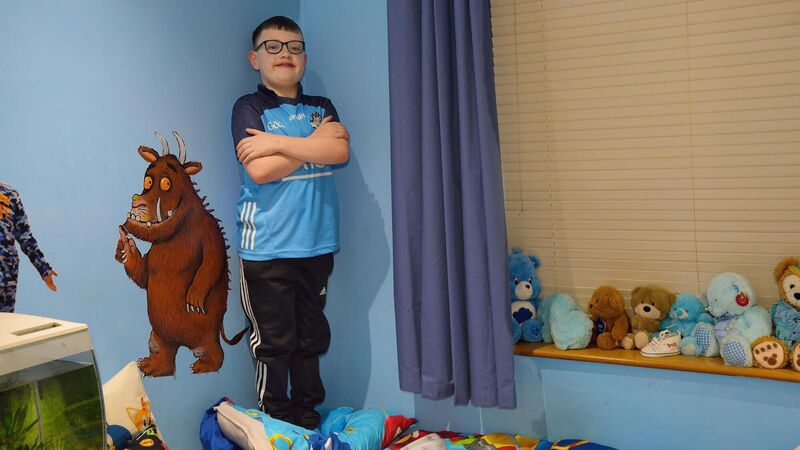Model of Brody's heart helps doctors prepare for his surgery

Brody Ellis, eight, who has had multiple open heart surgeries, recently underwent his fourth operation in Crumlin Children's Hospital - where on this occasion 3D printed models of his heart prior to surgery enabled cardiologists to plan and then safely perform the operation by keyhole surgery also allowing for a much quicker recovery time for Brody. Photograph Moya Nolan
IT WAS one of the most surreal moments of Georgina Ellis’s life — when the Dublin mum held an exact replica of her son Brody’s heart in her hands.
“Nobody ever expects to be able to hold their own child’s heart in their hands. It’s so unusual, amazing, and quite special,” she says.
“I’m sure I’m one of the few parents in the world who got to do this.”
What Georgina was holding was a 3D-printed model of Brody’s heart, created ahead of the eight-year-old having keyhole heart surgery last November.
For Georgina, Brody’s dad Wayne Ellis, and — of course — for the boy himself, it had been a long road up to this point.
While pregnant, they had been told at the 20-week scan that their baby had a congenital heart defect. There had been no issues with Georgina’s pregnancy, she was “perfectly fit and healthy”, and neither she nor Wayne had any family history of heart disease.
“But they could see this anomaly in his heart. The cardiologist told us the left ventricle hadn’t formed properly and that, without intervention in the first five days of his life, he wouldn’t survive. It was awful, devastating and so scary.”
Recalling how from that moment she couldn’t enjoy her pregnancy, Georgina nevertheless “wanted to be pregnant forever — because I knew what was going to happen when he was born”.
The couple had been warned that their baby “could be quite blue and mightn’t cry” when he arrived, but in fact Brody was “screaming like any other baby”.
That he was “very pink and very loud”, Georgina adds, “a lovely moment”. But the reality of his condition meant such moments were short-lived.
“I got enough time to hold him for a photo before he was taken to NICU (neonatal ICU). He was transferred to Crumlin when he was three hours old.”

At three days old, in a six-hour procedure, he underwent open heart surgery.
“We were very worried and scared,” Georgina recalls, adding that the operation was a success.
“But we knew he’d need another two surgeries further on.”
Arriving home six weeks post-surgery, Brody was “mostly well” — though with some feeding issues.
He had his second heart surgery when he was six months old.
“He was OK for a week afterwards, but then he went downhill. He ended up with massive heart failure.
“They told us he’d more than likely need a heart transplant. We went through all the stages of [preparedness] to be on the transplant list, but [medics] wanted to see how he would do with his own heart.
“He was in hospital for three months, but gradually improved.”
At five years old, Brody was quite well at this stage. However, he was becoming breathless and had further open heart surgery.
In the months leading up to this procedure, medics realised he would also need subsequent keyhole surgery.
“We were told this keyhole procedure was a new one — only a dozen had been done worldwide,” Georgina adds.
Months after the latest, Brody is thriving. “He’s like a brand new child – pink, running, he has loads of energy. Twenty-four hours after the keyhole surgery, he was pretty much the best he ever was.
“After the other surgeries, he’d have been heavily sedated.
“To see him awake after this one, talking, eating and drinking minutes after the surgery was magical.”
Huge progression
Seeing — and holding — the 3D-print model of her child’s heart ahead of the keyhole procedure helped Georgina understand what Brody would go through.
“It gave me relief to know exactly what paths through his heart they would take, and that they were able to plan the surgery. They explained everything very well.”
Consultant paediatric cardiologist Colin McMahon, at Crumlin (CHI), is professor of paediatric cardiology at UCD. He says 3D-printed models of hearts represent a huge progression in how doctors take care of children with congenital heart disease.
“We were one of the first centres in Europe to start 3D printing in 2015/16,” he says, confirming that close to 100 3D models have now been printed.
“We print 15-20 3D models a year for heart surgery and five to 10 for cardiac catheterisation.”
3D-printed models of a child’s heart are created only for complex cases that present a challenge when it comes to medical decision-making, Prof McMahon explains.
“We use them in complex congenital cardiac lesions, such as double outlet right ventricle. We also use them for multiple holes in the heart, or in patients who have only one ventricle instead of two.”
Prof McMahon confirms that in 30-40% of complex cases, 3D-printed hearts give additional information that helps with decision-making.
“Nowadays, if the cardiac surgery involves a complex cardiac defect the surgical team will often request a 3D-printed model to help with planning the operation.
“It helps the surgeon ensure the surgical strategy is the best one. It helps with assessing the anatomy, prior to the heart being opened, so that surgery can be planned ahead. And our surgical colleagues are able to rehearse the surgery and even decide the size of patch that will be required to close some holes.”
Pointing out that it is understandably very difficult for parents to visualise what will happen in a child’s heart operation, Prof McMahon says 3D-printed models are helpful for parents.
“It helps them understand and give consent for the operation.”
Parents, he says, can be “quite blown away” at seeing a replica of their child’s heart.
“They are often quite overwhelmed to see a perfect replica of their child’s heart, especially after dealing with the child’s condition for a long time. They find it very educational. It provides them with clarity and gives them confidence and reassurance.”
The process of creating a 3D-printed heart model starts with a CT scan of the heart, which generates data that in turn generates an STL (stereolithography — a popular 3D-printing technology) file.
“From that, the model can be printed in flexible silicone,” Prof McMahon says, adding CHI is partnered with centres in Belfast and Belgium, “which assist us in generating the models”.
It takes approximately three to five days to get the models back to Dublin. “And that’s OK because most cases are elective ... [but] we’re hoping we will have access to our own 3D printer in the new children’s hospital, which would make the technology more widely available for more cases to be done.
“We’d hope then that turnover would be as short as 24-36 hours.”

Holy grail of printing
Prof McMahon points to advances in materials science that are benefitting 3D-model printing. “The material replicates cardiac tissue. In consistency, it feels very much like human tissue, which is really important for the surgeon. In the future, we’ll be using 3D to print patient-specific tissue, using cells derived from the blood or potential stem cells — that’s the holy grail of 3D printing.”
3D printing complements other high-quality diagnostic imaging tools — like CT scan, echocardiogram, and MRI — with the cost of a standard 3D- model being €500 to €700, rising to €1,500 for the most modern materials.
“It’s a very small cost if it makes such a big difference in a child’s life,” he says, adding that these costs are part of the cardiology budget.
Meanwhile, Brody Ellis got to hold the 3D model of his own heart and be photographed with it. “He was amazed, he said it was so cool,” Georgina says.
Now in second class at school, Brody is getting on with life. “He likes video games, he likes to draw. He’s very funny and friendly, very witty,” Georgina adds. “He got ‘maths student of the week’ last week because he has come on so well in maths this year. He’s a very happy child and very kind to others.”
- Congenital Heart Defect (CHD) Awareness Week runs until Valentine’s Day. See: exa.mn/wear-red-campaign
CONNECT WITH US TODAY
Be the first to know the latest news and updates







